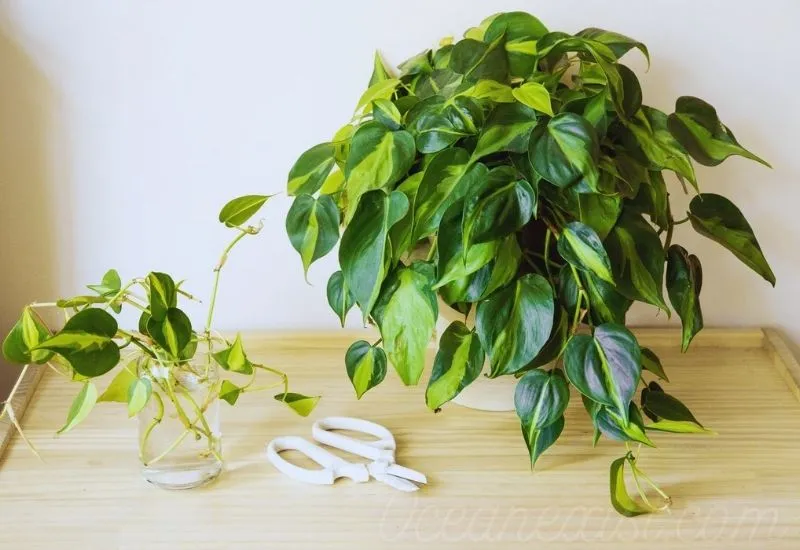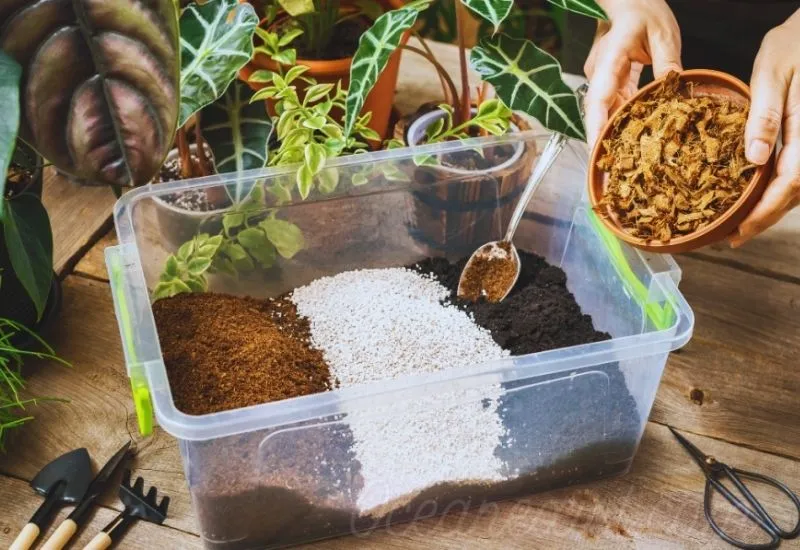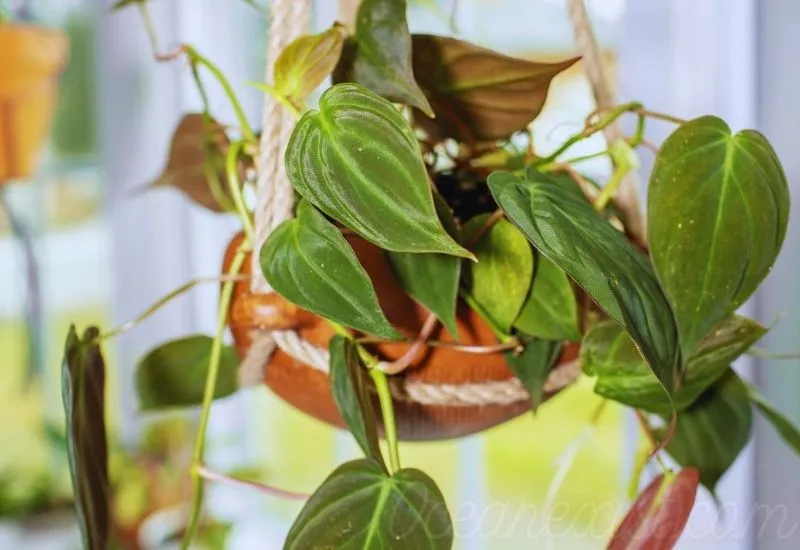In this blog post, you’re going to learn how to easily propagate and care for Philodendron micans.
This is a comprehensive guide covering reliable information about different aspects of this cultivated variety.
In this post, I’ll cover:
- Interesting Facts
- Propagation
- Repotting
- Care
And
- Solutions to Common Problems
So, if you are looking to propagate and care for Philodendron micans, this guide is for you.
Fun Facts
| Common Name | Velvet Leaf Philodendron |
| Botanical Name | Philodendron hederaceum |
| Family | Araceae |
| Plant Type | Vine, houseplant |
| Mature Size | Up to 8 feet (243.84) |
| Sun Exposure | 8 to 10 hours of indirect sunlight |
| Soil Type | Organic, moist, well-drained |
| Soil pH | Acidic |
| Native Area | Caribbean, Mexico, Central to South America |
| Toxic | Contains calcium oxalate crystals |
| Growth | Fast |
Philodendron micans is a vining species famous for its velvety, heart-shaped dark green leaves. This plant shows better growth when supported by structures such as metal fencing, vine support, plant wall support, vine support arch, trellises, and moss poles.
Benefits
Philodendron micans provides several benefits to us. Some of them are the following.
- They continuously purify the air of our room. They intake chemicals and toxins such as formaldehyde, etc. in this way, they are contributing to your health.
- This vining species doesn’t require any special conditions. You can maintain them in normal conditions.
- This is an aesthetically versatile plant. You can decorate the walls of your
- Room with branches and beautiful leaves.
Propagation

These are very rare plants. However, they can be propagated easily. One of the easiest ways to propagate them is through stem cuttings.
- First of all, cut a healthy branch with three to five leaves with a disinfected and sharp knife or pair of scissors.
- Then, expose the nodes from one side and put that side in clean and clear water. Place that water container in indirect sunlight. It will take three to four weeks for the roots to appear.
- When roots reach one to two inches, dip them in growth hormone. This will increase the growth of this plant.
- Now, prepare the moist soil mixture. Make a small hole with the pen. Then insert that cutting in that hole.
You have to maintain the soil’s moisture in the first two weeks. But not water logging. This plant will start producing leaves after one or two months.
Repotting
In the case of Philodendron micans, repotting is not recommended. It can cause root rotting in this plant and stunt the growth. However, if you think your plant really needs a bigger pot, then go for these steps.
- Remove the vine from its previous pot without damaging its roots. You can tilt the pot or use any instrument to remove soil from the pot.
- Trim dead or diseased roots and branches from the plant.
- Make the soil mixture in a pot slightly larger than the previous one. If your previous pot was 14 cm in diameter, you can use a pot of 16 cm in diameter.
- Now, hold the plant in the center of the pot with one hand and put the soil mixture slowly around the plant. After filling the pot with soil, water the plant.
In the first week, you have to water daily but in small quantities to keep the soil moist. After this, you can follow the previous routine.
Care
Pruning
Pruning is done for several purposes. It produces new, vibrant branches that make your plant more attractive. Vines can grow in different directions without maintaining the proper shape and structure. So, pruning will give them the desired shape. Moreover, it provides stem cuttings that can grow in new plants.
As Philodendron micans have vining growth, it will be tricky to prune them. For proper pruning, you can follow the steps below.
- Take a sharp pair of scissors and disinfect it with alcohol.
- Analyze the plant keenly; if you see diseased, damaged, yellowed leaves or branches, this is where you have to prune.
- Cut that damaged part from a little above the nodes.
In this way, remove all the damaged parts that are giving an awkward outlook. You can prune the plant in the desired shape by removing extra branches.
Soil

Just like other Philodendron species, the potting soil should have the following characteristics.
- Porous
- Well-aerated
- Well drained
- Fertile
- Organic
You can buy soil for your plant or make it by mixing different constituents. Therefore, mix the following items to make this soil.
- Peat moss or coco coir
- Perlite
- Compost or orchid bark
You can add fertilizer to make it fertile and nutritious.
Pot
The size and drainage of the pot are crucial for the plant. It should be large enough for its roots to thrive easily. Moreover, there must be small holes that allow the extra water to drain from the pot. Moreover, as it is a vine, you can use a hanging basket for this plant.
Therefore, if you have a pot, it should be 15-20 cm in diameter. However, you can use baskets of different sizes depending on the plant’s size.
Water
Philodendrons have sensitive roots. You have to protect them from both drenching and drying. Both these extreme conditions can affect plants severely. For proper growth, you should maintain a watering routine. However, this routine will change with the seasons. Therefore, the rule of thumb is to wait for the soil to dry for the next watering.
In spring and summer, their growth is at maximum rate, so water them frequently. On the other hand, in autumn and winter, they are in the dormant phase, so you should water them once a month.
Light
This plant needs a medium amount of bright indirect sunlight. Too much amount of direct sunlight can scorch the leaves. On the other hand, too little amount of Light can decrease the characteristic color and texture of the leaves. So, ideally, you should provide this plant with eight to ten hours of indirect sunlight.
Placement
The amount of sunlight and humidity depends upon the placement. So you have to choose a spot providing adequate sunlight. You can place your PhilodendronPhilodendron in your kitchen, bathroom, living room, home jungle, or lawn. But make sure the amount of Light is adequate for your plant.
It is recommended to place your plant in front of windows that are facing the sun from east or north.
Fertilizer
Fertilizers provide these plants with nutrients. They need continuous nutrient feed to maintain the velvety appearance of leaves. However, the amount of fertilizer will depend upon the phase of the plant. If the plant is in the growth phase, you have to fertilize it once a month. However, in the dormant phase, you can feed once in two months with fertilizers.
The recommended ratio of fertilizer is 2-1-3 NPK. However, some use 20-20-20 NPK for their Philodendrons.
Over-fertilizing can damage roots, as their chemicals accumulate in the soil and result in root rot.
Common Problems
Pests
Pests destroy your plant by weakening it. It absorbs all their nutrients and lets your plant die. Different types of pests have different effects. For example, spider mites, mealy bugs, and aphids suck the sap from the leaves’s veins. Further, it can distort leaves and form white specks and yellow or brown leaves.
First of all, remove the visible pests from the leaves. You can spray with pesticides or neem oil mixture with water over the infected parts of the plant. However, you can separate that damaged part from the healthy plant.
Low Temperature
Philodendron micans are tropical plants. They need high temperatures and humidity. Temperatures lower than 54°F (12°C) will result in the curling of the leaves. Moreover, at lower temperatures, plants can’t grow and have smaller sizes.
Therefore, you have to maintain a temperature above 60°F.
Fungal Diseases
The fungus can cause infection in the leaves and form rusty dots on them. It is preferred to remove that infected part from the healthy plant. Or you can spray a copper-based fungicide or a python. Some gardeners use baking soda to treat fungal infections.
Brown Tips
Brown tips also appear on the leaves for several reasons. Over and underwatering, sunburn, low humidity, and infections caused by pests, fungi, and bacteria are the leading causes of brown tips. Their treatment includes proper care, maintaining suitable conditions, and use of fungicides and pesticides accordingly.
Curling Leaves
According to some gardeners, it is said that leaves curl upward due to the underwatering. However, they turn downward due to overwatering. However, it is also due to the low humidity levels. So you have to regulate watering and install a humidifier near your Philodendron.
Varieties & Similar Plants
Philodendron micans is a climbing species. Several other species of PhilodendronPhilodendron are also vines.
Philodendron Brasil Vs Philodendron Micans

Both are vining plants. Their leaves are heart-shaped and velvety. However, they are different due to the different variegation in their leaves.
- The P. Brasil has a variegation of green and yellow color in their leaves. You will observe a golden streak in their leaves. The white-colored veins are very obvious in their leaves.
- The leaves of P. Micans have copper bronze on the upper side and are purple to bronze on the underside.
Ready to Grab a Philodendron micans to add beauty to your home garden?
All the above information is reliable, and you’ll see outstanding results if you want to grow or care for this plant.
